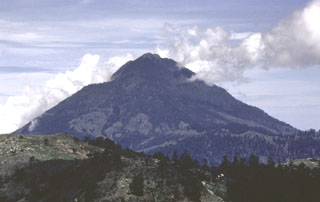Report on Tacana (Mexico-Guatemala) — June 1987
Scientific Event Alert Network Bulletin, vol. 12, no. 6 (June 1987)
Managing Editor: Lindsay McClelland.
Tacana (Mexico-Guatemala) Steam output decreases; gas analyses
Please cite this report as:
Global Volcanism Program, 1987. Report on Tacana (Mexico-Guatemala) (McClelland, L., ed.). Scientific Event Alert Network Bulletin, 12:6. Smithsonian Institution. https://doi.org/10.5479/si.GVP.SEAN198706-341130
Tacana
Mexico-Guatemala
15.132°N, 92.109°W; summit elev. 4064 m
All times are local (unless otherwise noted)
On 11 April a team of Italian scientists inspected the craters and fumaroles produced by the explosion. A steam column more than 100 m high was being emitted, but total steam output appeared to have decreased. The largest fumarole had a temperature of 89.3°C. Analysis of samples from that fumarole gave the following results (in volume percent): CO2, 1.07; H2O, 98.7; H2S, 0.15; N2, 0.019; H2, 0.00082; CH2, 0.00015; NH4, 0.000037; B, 0.00020; O2, 0.000016. The volcanologists interpreted the composition as resulting from the interaction of a convective flow of deep origin with a shallow aquifer. This interpretation appeared to correlate with the mainly phreatic character of the more recent activity, inferred from the deposits. The scientists felt that phreatic explosions of weak intensity could provide a sufficient trigger for dangerous landslides because of the volcano's steep slopes.
Geological Summary. Tacaná is a 4064-m-high composite stratovolcano that straddles the México/Guatemala border at the NW end of the Central American volcanic belt. The volcano rises 1800 m above deeply dissected plutonic and metamorphic terrain. Three large calderas breached to the south, and the elongated summit region is dominated by a series of lava domes intruded along a NE-SW trend. Volcanism has migrated to the SW, and a small adventive lava dome is located in the crater of the youngest volcano, San Antonio, on the upper SW flank. Viscous lava flow complexes are found on the north and south flanks, and lobate lahar deposits fill many valleys. Radial drainages on the Guatemalan side are deflected by surrounding mountains into the Pacific coastal plain on the SW side of the volcano. Historical activity has been restricted to mild phreatic eruptions, but more powerful explosive activity, including the production of pyroclastic flows, has occurred as recently as about 1950 years ago.
Information Contacts: M. Martini, Univ di Firenze, Italy.

